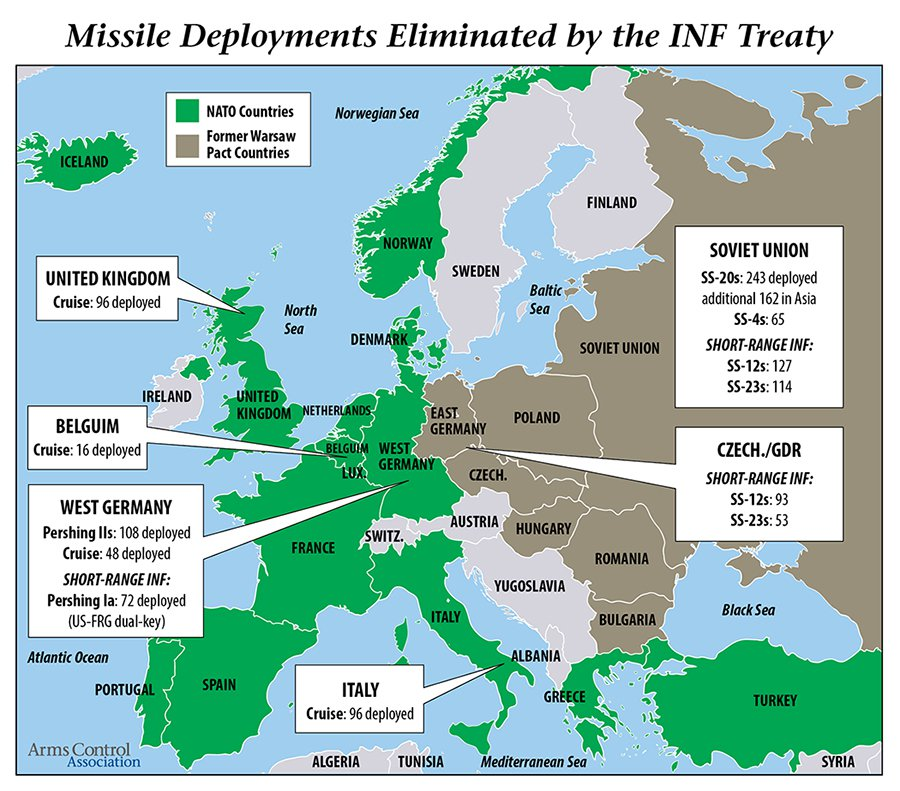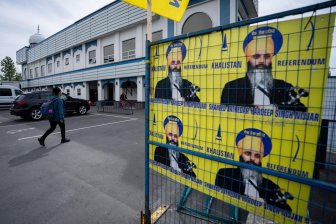The U.S. has announced Friday it intends to withdraw from a Cold War-era nuclear treaty with Russia.

The treaty, called the Intermediate-Range Nuclear Forces treaty, was inked in 1987 and aimed to “eliminate and permanently forswear” nuclear and ground-launched ballistic and cruise missiles with intermediate range (500-5,500 kilometres).
The treaty came about in the height of the then-Soviet Union, when the country deployed SS-20 intermediate-range missiles in the mid-1970s, the Arms Control Association explained.
U.S. missiles were placed in Europe to be able to counter those missiles in the 1980s.
Talks between former U.S. president Ronald Reagan and former Soviet general secretary Mikhail Gorbachev started in 1985, and started as a balance between the number of missiles each side had.
The talks continued for years, and the pair moved towards eliminating the mid-range missiles from deployment around the world.
By Dec. 8, 1987, the INF Treaty was signed. Both countries destroyed a total of 2,692 missiles.
In 1991, after the dissolution of the Soviet Union, the treaty membership expanded to include the Union’s successors.
The Arms Control Association notes that before today, there were five active members: The U.S., Russia, Belarus, Ukraine and Kazakhstan.
But European countries (both NATO and non-NATO countries) which possessed intermediate-range missiles have also complied with the treaty, destroying them.
WATCH: Pompeo says talks will continue with Russia after INF pull-out

What’s at issue today?
On Friday, the Trump administration said it was freeing itself from the constraints of the treaty – blaming Russia for knowingly violating the agreement.
“For too long,” President Donald Trump said in a written statement issued by the White House, Russia has violated the treaty “with impunity, covertly developing and fielding a prohibited missile system that poses a direct threat to our allies and troops abroad.”
Officials from the U.S. and Europe say new cruise missiles from Russia violate the treaty. Russia denies this, saying the missile’s range is outside the treaty constraints.
Russian officials have called the accusation a “false pretext” to exit the treaty.
WATCH: Russia shows missile to disprove U.S. allegation of violating arms treaty

NATO has backed the U.S. withdrawal, and other allies have agreed Russian missiles are not in compliance.
Technically, it will take six months to formally withdraw from the treaty, leaving a window for talks to continue.
World leaders are warning against the dissolution of the treaty, saying it could lead to another arms race.
“We will do everything possible to use the six-month window to hold further talks,” German Chancellor Angela Merkel said. “It is clear to us that Russia has violated this treaty… The important thing is to keep the window for dialogue open.”
Concern about missiles in China
Experts have also warned about a growing arsenal in China, which is not part of the pact.
“The strategic rationale for leaving the INF seriously involves China,” Behnam Ben Taleblu, a defence expert at the Foundation for Defence of Democracies, told the Associated Press in an interview.
“This is one medium by which China can contest American influence in the Asia-Pacific,” he said. “And it’s unfair for the U.S. to voluntarily restrict itself in a bilateral treaty when one side of that partnership (Russia) is failing to live by its obligations. The U.S. … is voluntarily fighting with one hand tied behind its back.”
Back in October, when Trump first announced his intention to leave the treaty, he said the U.S. would “have to develop” intermediate missiles.
“If Russia’s doing it and if China’s doing it, and we’re adhering to the agreement, that’s unacceptable,” he said at the time.
WATCH: Trump threatens to build up U.S. nuclear arsenal against Russia, China ‘until they come to their senses’ (Oct. 2018)

Does this affect other treaties
The official said the administration had begun to deliberate whether extend the “New Start” arms control treaty, which went into effect in 2011 and required both nations to cut their deployed strategic nuclear warheads to no more than 1,550, the lowest level in decades.
That treaty, which also limits deployed land- and submarine-based missiles and nuclear-capable bombers, expires in February 2021, can be extended by five years if both sides agree.
WATCH: The U.S. is fired up over its Cold War-era nuclear treaty with Russia

— with files from the Associated Press and Reuters





Comments